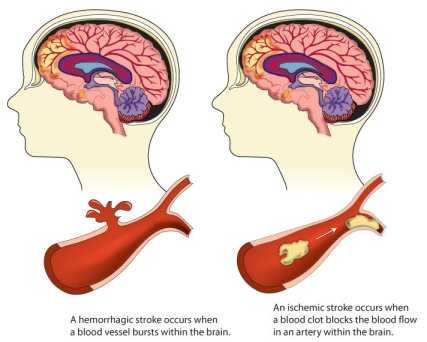Types of Stroke

The type of stroke you have affects your treatment and recovery.
The type of stroke you have affects your treatment and recovery.
The three main types of stroke are:
Learn about the health conditions and lifestyle habits that can increase your risk for stroke.
Ischemic Stroke
Most strokes (87%) are ischemic strokes.1 An ischemic stroke happens when blood flow through the artery that supplies oxygen-rich blood to the brain becomes blocked.
Blood clots often cause the blockages that lead to ischemic strokes.
Hemorrhagic Stroke
A hemorrhagic stroke happens when an artery in the brain leaks blood or ruptures (breaks open). The leaked blood puts too much pressure on brain cells, which damages them.
High blood pressure and aneurysms—balloon-like bulges in an artery that can stretch and burst—are examples of conditions that can cause a hemorrhagic stroke.
There are two types of hemorrhagic strokes:
- Intracerebral hemorrhage is the most common type of hemorrhagic stroke. It occurs when an artery in the brain bursts, flooding the surrounding tissue with blood.
- Subarachnoid hemorrhage is a less common type of hemorrhagic stroke. It refers to bleeding in the area between the brain and the thin tissues that cover it.
Transient Ischemic Attack (TIA)

For Blanche Teal-Cruise, a smoker for 40 years who also had high blood pressure, the transient ischemic attack (sometimes called a mini-stroke) she had on the way to work was a wake-up call.
A transient ischemic attack (TIA) is sometimes called a “mini-stroke.” It is different from the major types of stroke because blood flow to the brain is blocked for only a short time—usually no more than 5 minutes.2
It is important to know that:
- A TIA is a warning sign of a future stroke.
- A TIA is a medical emergency, just like a major stroke.
- Strokes and TIAs require emergency care. Call 9-1-1 right away if you feel signs of a stroke or see symptoms in someone around you.
- There is no way to know in the beginning whether symptoms are from a TIA or from a major type of stroke.
- Like ischemic strokes, blood clots often cause TIAs.
- More than a third of people who have a TIA and don’t get treatment have a major stroke within 1 year. As many as 10% to 15% of people will have a major stroke within 3 months of a TIA.2
Recognizing and treating TIAs can lower the risk of a major stroke. If you have a TIA, your health care team can find the cause and take steps to prevent a major stroke.
More Information
From CDC:
- Stroke
- Know the Facts About Stroke [PDF–264K]
- Know the Signs and Symptoms of Stroke
- Women and Stroke [PDF–268K]
- Men and Stroke [PDF–248K]
- African-American Women and Stroke [PDF–910K]
- African-American Men and Stroke [PDF–478K]
- Hispanic Women and Stroke [PDF–327K] – Las Mujeres Hispanas y Los Accidentes Cerebrovasculares [PDF–223]
- Hispanic Men and Stroke [PDF–340K] – Los Hombres Hispanos y Los Accidentes Cerebrovasculares [PDF–221]
- Hispanics and Stroke [PDF–217K] – Las Personas Hispanas y Los Accidentes Cerebrovasculares [PDF–223]
From other organizations:
- What You Need to Know About Stroke–National Institute of Neurological Disorders and Stroke
- Know Stroke: Know the Signs. Act in Time.–National Institutes of Health
- Mind Your Risks–National Institutes of Health
- Stroke–Medline Plus
- Brain Health Resource Page–American Heart Association/American Stroke Association
- Internet Stroke Center
- What is Stroke? –National Stroke Association
References
- Mozzafarian D, Benjamin EJ, Go AS, Arnett DK, Blaha MJ, Cushman M, et al., on behalf of the American Heart Association Statistics Committee and Stroke Statistics Subcommittee. Heart disease and stroke statistics—2016 update: a report from the American Heart Association. Circulation 2016;133(4):e38–360.
- American Heart Association/American Stroke Association. TIA (Transient Ischemic Attack). Accessed October 6, 2016.
- Page last reviewed: August 24, 2017
- Page last updated: August 24, 2017
- Content source:



 ShareCompartir
ShareCompartir